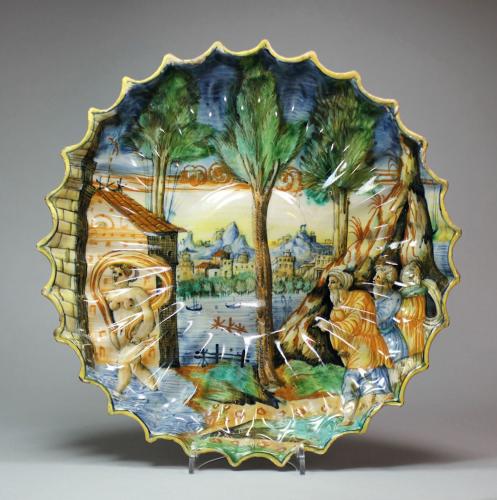
Price on application
This object is eligible for a Certificate of BADA Provenance
The BADA Standard
- Since 1918, BADA has been the leading association for the antiques and fine art trade
- Members are elected for their knowledge, integrity and quality of stock
- Our clients are protected by BADA’s code of conduct
- Our dealers’ membership is reviewed and renewed annually
- Bada.org is a non-profit site: clients deal directly with members and they pay no hidden fees
Chantilly Porcelain Red Dragon Saucer Dish, circa 1740, of lobed form with gilt scalloped decoration to the rim, the basin decorated in predominantly red enamels and gilt with a central roundel of two confronting phoenix, claws outstretched and long tails forming a perfect circle, the flat rim with two rampaging dragons, with three claws on each foot, upturned snouts and feathered manes, and two assortments of beribboned and tasselled precious objects, the reverse with a gilt horn and impressed horn mark.
Diameter: 22.5cm. (8 7/8 in.)
Condition: Perfect.
A similar dish can be found in the collection of the Victoria and Albert Museum (22-1902). Another example can be found in the collection of the Musée Condé, Chantilly and is illustrated in G. Le Duc (1995) Porcelain tendre to Chantilly au XVIIIe siécle, p.65.
This example dates from the earlier period of Chantilly production, which was defined by a strong Asian influence, with the blues and soft reds of Kakiemon porcelain being particularly favoured by the avid collector of Asian ceramics Louis Henri de Bourbon, Prince of Condé, who founded the Chantilly manufactory in 1730. Other European manufactories, most notably Meissen, produced services of this same design, but differed from Chantilly in that the latter did not use kaolin and so produced wares of a softer body (‘soft-paste’). For two Meissen examples with the same pattern produced for the Saxon court from around the same time as this Chantilly saucer see the collection of the Rijksmuseum, Amsterdam (BK-15226-B/BK-15226-A). In 1735 Chantilly was granted a special patent by Louis XV, giving the manufactory the right to make porcelain ‘façon de Japon’. By the 1750s however, Condé had died and the factory had relocated, now producing a wider variety of designs which were not necessarily directly influenced by wares from Japan.
Dimensions
Diameter: 22.5cm. (8 7/8 in.)Condition report
PerfectStock number
W717The BADA Standard
- Since 1918, BADA has been the leading association for the antiques and fine art trade
- Members are elected for their knowledge, integrity and quality of stock
- Our clients are protected by BADA’s code of conduct
- Our dealers’ membership is reviewed and renewed annually
- Bada.org is a non-profit site: clients deal directly with members and they pay no hidden fees


